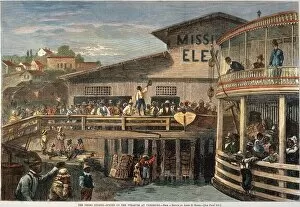Black Exodus Collection
"Black Exodus: Seeking Freedom and Opportunity" In the late 19th century
All Professionally Made to Order for Quick Shipping
"Black Exodus: Seeking Freedom and Opportunity" In the late 19th century, a significant movement known as the Black Exodus emerged in response to the dire circumstances faced by African Americans in the South. Handbills issued by Benjamin Pap Singleton at Nashville and urging blacks to go to Kansas became symbols of hope for those seeking a better life. The year 1877 marked a turning point as black migrants began fleeing the South due to an outbreak of yellow fever. Contemporary American wood engravings vividly captured their journey, depicting scenes of families making their way towards Kansas, where they believed freedom awaited them. Topeka, Kansas became a terminus for this exodus following the end of Reconstruction. Buildings were repurposed to accommodate black migrants who sought refuge from oppressive conditions. Religious services held within these buildings provided solace and strength during uncertain times. Colored engravings from 1879 showcased both the determination and resilience of these individuals who left everything behind in search of a brighter future. The scene outside one such building depicted an atmosphere filled with anticipation as black migrants gathered together, supporting each other on their shared path towards liberation. Vicksburg, Mississippi served as another departure point for many black migrants embarking on this transformative journey. Wood engravings captured poignant images of individuals bidding farewell to loved ones before boarding ships bound for points north and west, including Kansas. The Black Exodus was not just about physical relocation; it represented a collective yearning for freedom from oppression and discrimination that had plagued African Americans since slavery's abolition. It symbolized their unwavering belief in creating new opportunities through sheer determination and perseverance. This pivotal moment in history reminds us that even amidst adversity, communities can unite with resilience and courageously forge paths towards justice and equality. The legacy of those who participated in this mass migration continues to inspire generations today – reminding us all that change is possible when we stand together against injustice.









